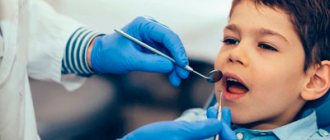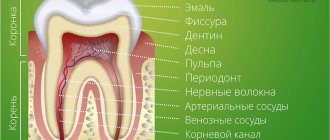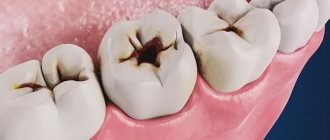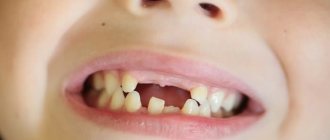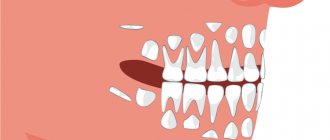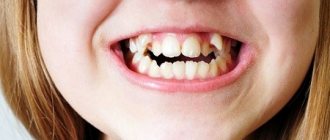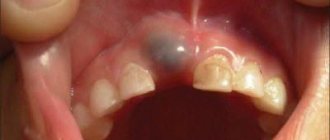Stopping the development of caries
It is advisable to stop the development of caries at the earliest possible stage: in this case, the disease will be much easier to treat.
At the initial stage, caries looks like a small spot. At this stage of development, it can be coated with a special gel that can restore damaged enamel. If you see a doctor on time, you may be able to do without the preparation procedure, which is, of course, completely painless.
If you start the development of caries, you will have to resort to drilling, and if the pulp is affected, this can add additional painful sensations.
In addition, ignoring caries is fraught with:
- destruction of the affected tooth and, as a result, expensive installation of an implant;
- indigestion, since the affected teeth cannot fully cope with the chewing function;
- aesthetic inconveniences.
What is ICON treatment for caries of primary teeth and how is it carried out?
The ICON procedure can help with superficial caries of primary teeth. Methodologically, it is similar to silvering. Damaged enamel is coated with a special active composition that destroys carious bacteria and activates regeneration processes.
This does not require drilling, and the solution itself is transparent and invisible to the eye. It “preserves” caries, preventing its development, and activates the natural restoration of the tooth.
Pros and cons of ICON treatment
The ICON technique is the most modern method of caries treatment. It is characterized by high efficiency and comfort for the patient:
- The child does not experience any unpleasant sensations
. At all. The carious spot does not need to be drilled; it is simply covered with active gel using a special brush. - The active gel penetrates the micropores of enamel and dentin, destroying bacteria even in the most inaccessible places.
- The gel is transparent and completely invisible.
There is also a downside - this procedure is a little more expensive than silvering, and will also only help in the treatment of superficial caries (however, like silvering). But when it comes to the health of not only baby teeth, but permanent teeth, saving is not something that should serve as a motivator for loving parents.
Prevention of caries: local methods
These methods of preventing caries include:
- Remineralization is a procedure during which tooth enamel is saturated with fluoride and calcium, which has a positive effect on its strength. In addition, fluoride prophylaxis increases the resistance of enamel to microorganisms that provoke the development of caries.
When acidity drops below pH5, the concentration of calcium and a number of other elements in tooth enamel begins to rapidly decrease. It is at this moment that the greatest activity of cariogenic organisms is observed. After covering the tooth surface with fluoride varnish, fluorine begins to penetrate into the enamel, which, together with calcium, does not allow it to dissolve even in conditions of high acidity.
Remineralization can be:
- Homemade, which consists of the most ordinary thorough brushing of teeth with toothpastes containing fluoride. There are pastes with more effective amino fluoride (they have a higher price and a faster penetration rate of fluoride into the enamel), as well as with sodium monofluorophosphate (they are a budget option). For a more professional fluoride prophylactic course, in addition to toothpastes and rinses, you will need remineralizing gels, which need to be used every 3-4 months, which does not replace brushing your teeth. If you follow these rules throughout your life, there's a good chance you'll never have to treat tooth decay.
- Professional , for which you cannot do without visiting a doctor. Its main advantage is better efficiency due to the use of drugs characterized by a higher concentration of active substances. During the procedure, the teeth are coated with a transparent fluoride-containing varnish, which actively penetrates the enamel over the course of several hours. Gradually the film dissolves.
WHO recommends fluoride prophylaxis in two ways: using fluoride pastes at home and periodically resorting to the use of professional preparations that modern dentistry can offer.
- Proper oral hygiene , which is both a simple and very important step in caries prevention, prevents the appearance of carious areas.
A considerable part of people believe that their oral hygiene is absolutely fine. However, if this were true, the disease would not be so common.
Caries at 2 years old?
By the age of two, most children have most of their teeth present. Alas, the first signs of their carious and non-carious lesions appear precisely at this time, so parents need to carefully monitor this and, if stains appear on their teeth, immediately consult a dentist. And not only for the sake of the child’s future beautiful smile, but in the name of his health. The rapid growth process and rapid blood supply lead to the fact that if any infection appears in the body, it instantly spreads. For example, caries may be to blame for chronic tonsillitis and constant sore throats in a child.
A procedure such as remineralization—saturation of tooth enamel with mineral components (calcium, fluoride)—helps prevent the development of caries deep into the tooth and restore the protective properties of the enamel. Such non-invasive preventive therapy, by the way, is also in demand among adults.
Tooth decay is just around the corner. 7 unforgivable mistakes in dental care Read more
How to prevent tooth decay
- Regular brushing of teeth (preferably after every meal). Moreover, you should brush your teeth not an hour or two, but within 5 minutes after eating. It has been proven that food debris and pathogens cause maximum harm to teeth in the first 40 minutes. Is it necessary to brush your teeth after every meal, that is, even after a light snack or tea with candy? Yes, it is necessary, and you need to clearly understand this for yourself. Therefore, you should not overuse snacks during the day.
- Dental floss - This is not an additional tool for cleaning the oral cavity, but is as basic as a toothbrush. Floss must be used in the same way after each meal. For a person who has never used floss before, it may be difficult to understand how to use it - a dentist can help with this. The task of dental floss is to remove food debris between the teeth (caries, no less rarely, develops not only in the tooth cavity, but also between two adjacent teeth).
- What to do if brushing your teeth is problematic (for example, in a cafe or outdoors)? You should always have dental floss or, as a last resort, chewing gum with you. A package of thread does not take up much space, and you can use it by going to the toilet (if we are talking about a room) or stepping aside. Many people are embarrassed to behave this way, as a result, subsequently they will not always have simple and cheap treatment for caries. Embarrassment is inappropriate here: there is nothing shameful in getting up and going to the restroom for a couple of minutes. It’s much better to breathe in freshness afterwards, rather than “delight” those around you with the aromas of a recently eaten lunch.
- Food debris often accumulates under dentures and braces.. People who have crowns in their mouths can be advised to use an irrigator - a device that delivers a stream of water through a special nozzle, saturated with air bubbles and washing away food debris. The device is especially effective for gingivitis and periodontitis, when pockets form where a large number of microbes accumulate. Periodontal pockets are very difficult to clean with a brush or floss, but an irrigator can cope with this task perfectly. The device is also recommended for pregnant women, who often suffer from gingivitis.
In addition to brushing and flossing, the following can help prevent tooth decay:
- strengthening the immune system. A weakened body is not able to fully resist the effects of bacteria. To minimize the risk of developing caries, subject to good hygiene, you need to take care of your immunity through the use of vitamins and hardening;
- properly formulated diet. First of all, you need to reduce the consumption of simple carbohydrates, and also increase the amount of foods containing fluoride and calcium in the menu. We must not forget about regular consumption of hard fruits and vegetables, which cleanse teeth of plaque.
What is silvering of baby teeth and how is it done?
Silvering of baby teeth is a classic (or rather, outdated) method of treating caries in the initial stages. It can only help with superficial caries, when the stain is localized on the enamel and has not yet spread to the dentin.
Caries is caused by various microorganisms, primarily the Streptococcus family. During their life, they process glucose and other carbohydrates, releasing acid. It is this that dissolves the tooth enamel, causing caries.
When silvering, the surface of a tooth with a carious stain is coated with a special solution of silver nitrate. This noble metal has antiseptic properties. Under the influence of silver, microorganisms die, which can prevent the development of caries. The film of the substance itself remains on the surface of the tooth.
Silvering has a very important disadvantage - it does not work. More precisely, at the initial stages, the solution is actually capable of stopping the vital activity of bacteria. However, microorganisms will continue to develop in the future.
Pros and cons of silvering
The main advantage of silvering is its low price. Indeed, this procedure for treating caries in primary teeth is much cheaper than ICON or other methods. But this is the only advantage of silvering.
It is important to understand that silver is a short-term antiseptic. It actually kills bacteria immediately after application. However, in the future, microorganisms continue to develop, which means that caries remains untreated.
There are many more disadvantages to silvering:
- Teeth darken
. Silver nitrate penetrates the enamel, causing it to change color. Even a healthy tooth becomes black after the procedure, as a result of which the child may begin to experience complexes and problems with communication. - Can only help in the initial stages of superficial caries
. To prevent further development of the disease, it will also be necessary to adjust the child’s diet and change oral hygiene. - Silver causes burns
. If the solution gets on the pulp, the internal soft tissues of the tooth, it will begin to have a negative effect on it. The little patient will be in pain. If the burned pulp is left unattended, it can become inflamed and form pus.
Therefore, we do not recommend using the silvering technique to treat caries of primary teeth.
Caries: general methods of prevention
- The main reason for the development of caries is carbohydrates consumed during meals (simple carbohydrates, i.e. sugars, are especially harmful). As a rule, a person consumes these elements between main meals (for example, drinking tea with sugar or confectionery). If you give up snacking, you will reduce the risk of developing caries.
- The use of vitamins that prevent the development of caries. In Russia, this method is not very common, although the anti-caries effect of vitamins B6 and B1 has long been proven. However, no pill, even taken on a regular basis, can prevent tooth decay if oral hygiene suffers.
- Fluoridation. This method of caries prevention helps strengthen the strength of enamel, increase its resistance to acid, and also get rid of the pain reaction to eating too hot or cold food. In simple fluoridation, fluoride gel is applied to the tooth. Deep fluoridation involves sealing the enamel. This is a longer process in which the teeth are first dried, then deep fluoride is applied to them, followed by drying again and the use of copper-calcium hydroxide.
- Infiltration. With this method of preventing dental caries, the stain is lubricated with an etching composition, then a drug that seals the pores is applied to the cleaned surface of the tooth. Infiltration allows you to stop the development of caries and the increase in the size of the carious spot, since the acid released by bacteria is not able to penetrate into the enamel. The method is absolutely painless, therefore it is recommended, including for children. The only condition for successful completion of the procedure is sitting still for 20 minutes, so infiltration may not be suitable for restless children.
- Ozone therapy.
- Laser therapy.
If a hole has already appeared in the tooth, then the above prevention options will not help: you will have to resort to surgical intervention.
Dental caries in children
In children, identifying caries is quite simple: first, white or brown spots appear on the teeth, then the teeth begin to react to hot or cold food, and bad breath may appear. All these symptoms indicate the rapid development of the disease. If action is not taken in time, the infection can spread to several teeth at once.
Causes of caries development in children:
- The main cause of childhood caries is poor oral hygiene. The task of parents is to choose the right toothbrush for their child and teach him how to brush his teeth. Many young children are afraid of this harmless procedure, so we can recommend trying to present brushing as a game. It is necessary to accustom a child to brush independently starting from the age of 3 (before this moment, parents should brush the child’s gums and teeth).
- The infection can be transmitted from an adult to a child. As a rule, this happens if you eat with a child with the same spoon or kiss him on the lips, which is often abused by adults who are unable to cope with an overabundance of feelings.
- Genetic characteristics associated with abnormal maternal lifestyle during pregnancy. Teeth form during the first trimester, so if a woman smokes or drinks alcohol, this can affect the baby's dental development.
- Early caries, which appears in children before the age of 2 years, can be caused by poor mineralization of baby teeth.
- Various chronic diseases can also cause cavities.
- In infants, bottle tooth decay often occurs when the child eats food before bed. After eating, food residues remain on the teeth, and parents, instead of brushing the child’s teeth, put him to bed.
Not early, but just right
The foundation for a child’s future dental health can be laid already in the perinatal period. It is important that the mother takes a balanced multivitamin during pregnancy. This will definitely help the formation of teeth rudiments in the baby. It is also important for the expectant mother to take care of her own health: prevent diseases, eat right, avoiding sweets and refined foods, and take medications only as prescribed by the doctor. The fact is that a number of drugs have a negative effect on the formation of teeth, as a result they can begin to erupt with defects, stains on the enamel of a darker color (for example, “tetracycline teeth”).
Babies develop their first teeth by the age of one year. However, some babies become toothies even earlier, at 4 months. The enamel layer of the first teeth is thin, the dental and gum tissue is loose, and there are a lot of blood vessels in it. Therefore, the process of teething often becomes extremely painful for children (and unforgettable for parents). To relieve pain, it is recommended to use children's pain-relieving gels and anti-inflammatory drugs, and for hygiene, use special brushes that fit on an adult's finger and special 0+ toothpastes.
Teeth are cutting. What problems await parents Read more
conclusions
There is a clear algorithm, following which, with a high degree of probability, you will never encounter the problem of caries.
- Regular removal of plaque and tartar is the key to healthy teeth . Good oral hygiene is the best cure for any disease related to teeth and gums.
- Proper diet . It is necessary to compose the daily menu in such a way that it contains as little flour and sweets as possible (food consisting mainly of easily digestible carbohydrates). It is also worth giving up sugary drinks (soda contains an extremely large amount of sugar). By avoiding sugary snacks, you can minimize your risk of tooth decay.
- Measures that increase the resistance of enamel to acids produced by pathogenic microorganisms should be carried out several times a year.

